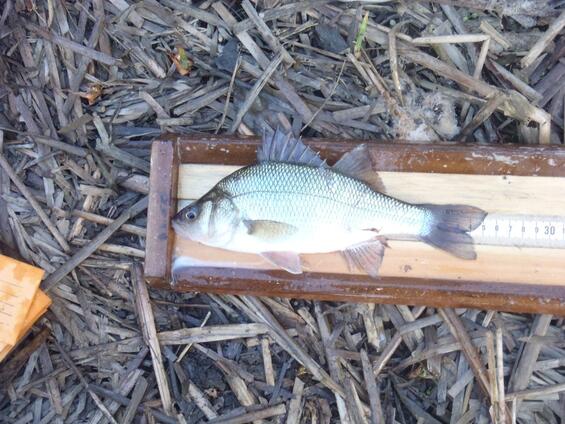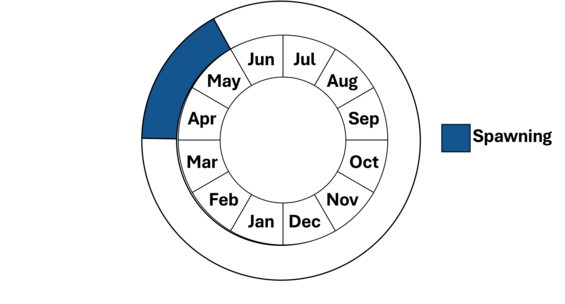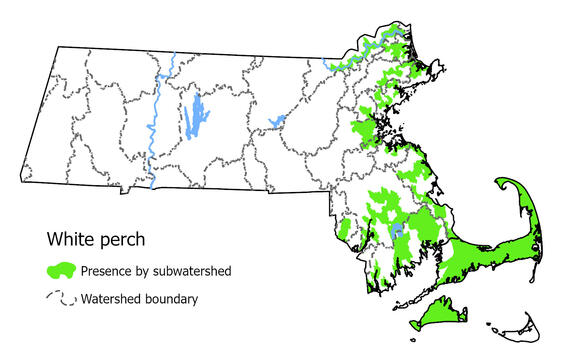- Scientific name: Morone americana
- Species of Greatest Conservation Need (MA State Wildlife Action Plan)
Description

Spawning run white perch (25 cm) caught in Jones River, Kingston, Division of Marine Fisheries fyke net
White perch are relatively deep-bodied, spiny fishes with two dorsal fins that are slightly connected and three anal spines. They are more closely related to striped bass than they are to members of the perch family. The color of the white perch can vary from silver to gray to olive depending on the waters from which they are collected. The color is uniform and lacks stripes, spots, or other markings. Typical adult fish range from 15 – 25 cm (6 - 10 in) and are <.45 kg (<1 lb) but can reach weights of more than 1.4 kg (3 lb).
Life cycle and behavior

White perch make short migrations from estuarine habitats up into freshwater portions of streams and rivers to spawn on sand and gravel bars (Mansuiti 1961; Lebida 1966). Most spawning occurs in April and May when water temperatures are 50 to 60 degrees Fahrenheit. During spawning, several smaller males attend a smaller number of larger females. Adhesive eggs are scattered on the sand and gravel. No nest is constructed and no parental care is given after the eggs are laid. Eggs typically hatch in less than the week with water temperature determining exact duration. White perch typically survive less than 10 years but can attain ages of closer to 20. While feeding, white perch often form large schools that can include several hundred fish. Small fish focus on plankton as the core of their diet and shifts to crayfish, aquatic insects, and small fishes as they get larger.
Population status
White perch population status is essentially undocumented in Massachusetts and poorly documented in other regions (Marcy and Richards 1974; and Bath and O’Connor 1982). Once known as a thriving recreational fishery in several coastal streams like the Parker River, white perch caught by anglers today typically occurs at spawning runs in a few coastal streams and from the introduced populations in inland lakes and ponds. Very little is currently known about the status of the estuarine populations as sampling them with standard electrofishing can be very difficult and angler input regarding the populations has become insignificant. The Massachusetts Division of Marine Fisheries has maintained rainbow smelt fyke nets in coastal rivers for 20 years. Nine sampled stations have all caught white perch, although some stations had intermittent catches and only three are active presently. These data can be summarized to provide some information on coastal occurrence and potentially indices of size and abundance.
Distribution and abundance
White perch can tolerate a wide range of salinities and are currently found in lakes, ponds, streams and rivers statewide due to stocking programs in the early 1900’s. The original distribution of white perch in Massachusetts was related to their diadromous life history and focused on estuarine habitats with populations extending into freshwater rivers and ponds connected to the ocean. It is the original coastal-related distribution that is included as a Species of Greatest Conservation Need. Abundances have declined in these estuarine populations but the extent to which they still persist is largely unknown.

Habitat
White perch are a fish of bays, saltwater ponds and shallow estuarine habitat and also inhabit portions of freshwater coastal rivers and lakes. Diadromous white perch undergo annual spawning runs at some coastal rivers in spring to spawn in brackish and freshwater river channels and ponds. Young-of-year white perch occupy these same habitats for a portion of their first year before migrating to marine waters.
Healthy habitats are vital for supporting native wildlife and plants. Explore habitats and learn about conservation and restoration in Massachusetts.
Threats
White perch have likely been reduced or eliminated in some waters by pollution and warming ocean temperatures associated with climate change, and habitat alteration. Other factors that have caused the decline in this species are fishing mortality focused on spawning runs, alteration of freshwater habitats, declines in water quality and quantity.
Climate change will be a concern going forward based on a recent marine and migratory fish vulnerability assessment (Hare et al. 2016). Marine habitats are affected as ocean temperature over the last decade in the U.S. Northeast Shelf and surrounding Northwest Atlantic waters have warmed faster than the global average (Pershing et al. 2015). New projections also suggest that this region will warm two to three times faster than the global average from a predicted northward shift in the Gulf Stream (Saba et al. 2016). Freshwater habitats in MA will also be affected by a high rate of sea-level rise, as well as increases in annual precipitation and river flow, magnitude of extreme precipitation events, and magnitude and frequency of floods and droughts (Hare et al. 2016).
Conservation
Existing populations are poorly studied and reported. Surveys of coastal white perch populations need to be designed to answer distribution and abundance questions in the near future to better develop population parameters.
References
Bath, D.W., and J.M. O’Connor. 1982. The biology of the white perch, Morone Americana, in the Hudson River Estuary. Fish. Bull. 80(3): 599-610.
Karsten E. Hartel, David B. Halliwell, and Alan E. Launer. 2002. Inland Fishes of Massachusetts. Massachusetts Audubon Society, Lincoln, Massachusetts
Hare, J. A., W.E. Morrison, M.W. Nelson, M.M. Stachura, E.J. Teeters, R.B. Griffis, M.A. Alexander... and A.S. Chute. 2016. A vulnerability assessment of fish and invertebrates to climate change on the Northeast US Continental Shelf. PloS one, 11(2), e0146756.
Lebida, R.C. 1966. The seasonal abundance and distribution of eggs, larvae, and juvenile fishes in the Weweantic River estuary, Massachusetts, 1966. M.S. thesis, Univ. of MA, Amherst, 59 pp.
Mansuiti, R.J. 1961. Movements, reproduction, and mortality of the white perch Roccus americanus in the Patuxent Estuary, Maryland. Chesapeake Science 2: 142-205.
Marcy, B.C., Jr. and F. P. Richards. 1974. Age and growth of the white perch Morone americana in the lower Connecticut River. TAFS 103(1): 117-120.
Pershing, A. J., M.A. Alexander, C.M. Hernandez, L.A. Kerr, A. Le Bris, K.E. Mills, ... and G.D. Sherwood. 2015. Slow adaptation in the face of rapid warming leads to collapse of the Gulf of Maine cod fishery. Science, 350(6262), 809-812.
Contact
| Date published: | August 18, 2025 |
|---|